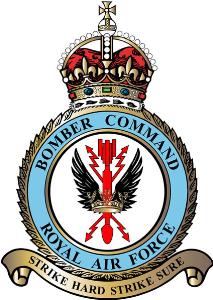
RAF Bomber Command controlled the Royal Air Force's bomber forces from 1936 to 1968. Along with the United States Army Air Forces, it played the central role in the strategic bombing of Germany in World War II. From 1942 onward, the British bombing campaign against Germany became less restrictive and increasingly targeted industrial sites and the civilian manpower base essential for German war production. In total 364,514 operational sorties were flown, 1,030,500 tons of bombs were dropped and 8,325 aircraft lost in action. Bomber Command crews also suffered a high casualty rate: 55,573 were killed out of a total of 125,000 aircrew, a 44.4% death rate. A further 8,403 men were wounded in action, and 9,838 became prisoners of war.

Royal Air Force Coningsby or RAF Coningsby, is a Royal Air Force (RAF) station located 13.7 kilometres (8.5 mi) south-west of Horncastle, and 15.8 kilometres (9.8 mi) north-west of Boston, in the East Lindsey district of Lincolnshire, England. It is a Main Operating Base of the RAF and home to three front-line Eurofighter Typhoon FGR4 units, No. 3 Squadron, No. 11 Squadron and No. 12 Squadron. In support of front-line units, No. 29 Squadron is the Typhoon Operational Conversion Unit and No. 41 Squadron is the Typhoon Test and Evaluation Squadron. Coningsby is also the home of the Battle of Britain Memorial Flight (BBMF) which operates a variety of historic RAF aircraft.

Royal Air Force Dishforth or more simply RAF Dishforth is a former Royal Air Force station near Thirsk in North Yorkshire, England. Opened in 1936, the base was used as a bomber airfield during the Second World War with both British and Canadian squadrons flying missions from the airfield. After the war, the base was used by various squadrons and training units before being disposed of in 1992 and handed over to the Army Air Corps.

Royal Air Force Finningley or RAF Finningley was a Royal Flying Corps and Royal Air Force station at Finningley, in the Metropolitan Borough of Doncaster, South Yorkshire, England. The station straddled the historic county boundaries of both Nottinghamshire and the West Riding of Yorkshire.

RAF Middleton St George is a former Royal Air Force (RAF) and Royal Canadian Air Force (RCAF) Bomber Command station during the Second World War. It was located in County Durham, 6 mi (9.7 km) east of Darlington, England. The station's motto was Shield and Deter. The aerodrome remains active as Teesside International Airport.

Royal Air Force East Kirkby or more simply RAF East Kirkby is a former Royal Air Force station near the village of East Kirkby, south of Horncastle in Lincolnshire, just off the A155. The airfield is now home to the Lincolnshire Aviation Heritage Centre air museum.
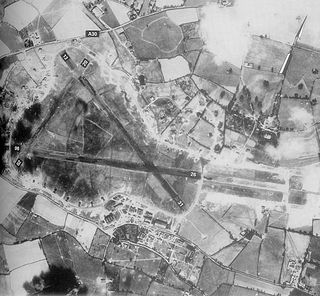
Class A airfields were World War II military installations constructed to specifications laid down by the British Air Ministry Directorate-General of Works (AMDGW). Intended for use by heavy bombers and transports, they were the standard air base design for the Royal Air Force as well as U.S. Army Air Forces units operating from the UK.

Royal Air Force Bawtry or more simply RAF Bawtry is a former Royal Air Force station located at Bawtry Hall in Bawtry, South Yorkshire, England and was No. 1 Group RAF Bomber Command headquarters and administration unit during and following the Second World War.

Royal Air Force Hemswell or more simply RAF Hemswell is a former Royal Air Force (RAF) station located 7.8 miles (12.6 km) east of Gainsborough, Lincolnshire, England.

Royal Air Force Fulbeck or more simply RAF Fulbeck is a former Royal Air Force station located 6.3 miles (10.1 km) east of Newark-on-Trent, Nottinghamshire and 10.9 miles (17.5 km) west of Sleaford, Lincolnshire, England.
Bruce Barrymore Halpenny was an English military historian and author, specializing in airfields and aircraft, as well as ghost stories and mysteries. He was also a broadcaster and games inventor.
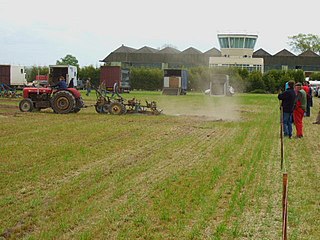
Royal Air Force Lindholme or more simply RAF Lindholme is a former Royal Air Force station in South Yorkshire, England. It was located 3.9 miles (6.3 km) south of Thorne and 6.9 miles (11.1 km) north east of Doncaster and was initially called RAF Hatfield Woodhouse.
Royal Air Force Sandtoft or more simply RAF Sandtoft is a former Royal Air Force station in North Lincolnshire between Doncaster, South Yorkshire and Scunthorpe, North Lincolnshire, England.

Royal Air Force Skipton-on-Swale or more simply RAF Skipton-on-Swale is a former Royal Air Force station operated by RAF Bomber Command during the Second World War. The station was located at Skipton-on-Swale 4 miles (6.4 km) west of Thirsk, North Yorkshire, England. The village of Sandhutton is located just to the east. RAF Skipton-on-Swale was a sub-station of RAF Leeming.
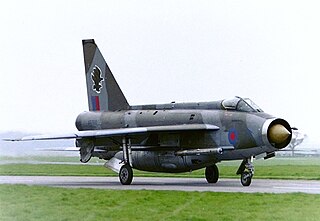
Royal Air Force Binbrook or RAF Binbrook is a former Royal Air Force station located near Binbrook, Lincolnshire, England. The old domestic site has been renamed to become the village of Brookenby. RAF Binbrook was primarily used by Bomber Command in the Second World War. The Central Fighter Establishment moved to Binbrook from RAF West Raynham between 1959 and 1962 and two English Electric Lightning squadrons were stationed there between 1965 and 1988.
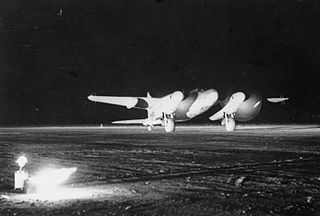
No. 256 Squadron RAF was a flying squadron of the Royal Air Force which operated during the First and Second World Wars. Initially equipped with Dh6 and Kangaroo aircraft, it operated Defiant Mk IIs, Beaufighters, and Mosquitoes in the Second World War.
Royal Air Force Doncaster or more simply RAF Doncaster, also referred to as Doncaster Aerodrome, is a former Royal Air Force station near Doncaster, South Yorkshire, England.

Royal Air Force Rufforth or RAF Rufforth is a former Royal Air Force station located near Rufforth in North Yorkshire, England. It was used by only one operational squadron on long-range bombing missions during the Second World War, with most flying dedicated to conversion units under the auspices of nearby RAF Marston Moor. Post-war, the RAF used the site to house maintenance units, gliding schools and observation flights. It was completely disposed of by the MoD in 1981, and now is used for civilian light aircraft and glider flying.

The Type-C hangar is a specific design of aircraft hangar built by the Royal Air Force during its expansion period of the 1930s. The hangar type generally measured 300 feet (91 m) in length, with a width of 152 feet 5 inches (46.46 m), and a clear height of 35 feet 4 inches (10.77 m). Whilst the type was designed, built and used during the expansion programme, installation of type-C hangars continued into the Second World War. By 1944, it was determined that in 64 RAF expansion period airfields, which were open at that time, at least one type-C hangar was present.
















